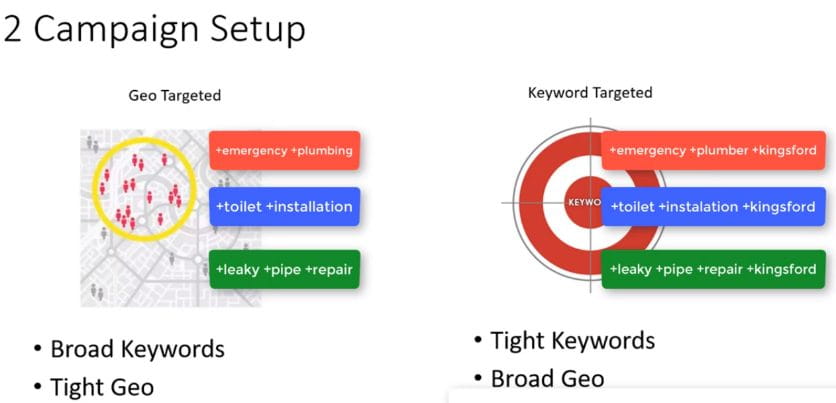
Email Marketing Insights in 2025 from Neil Patel
Neil Patel recently shared powerful tips on email marketing success—think cleaner lists, smarter personalization, and value-packed content. His key message? Email isn’t dead; it’s evolving.

In this section, we will discuss how you can use a double campaign structure for optimal geotargeting your searchers.
This double structure is relevant for any type of local business or a business that services a specific location. Some examples are:
The standard practice is to setup a campaign with the geolocation set to target a radius around the area that the business is serving. This is straightforward and it does work, but it will not give you maximum benefit.
Let’s say it’s the evening, I’m at home sitting on the couch and I need to make a booking at a dentist tomorrow. I go online and I search for ‘dental check-up’. This would be great if I wanted a dentist close to where I am searching for, but tomorrow I will be at work and I don’t work near my home. Because of the way I searched I will likely only see ads for dentists near my home. For advertisers using only geolocation targeting, this is not enough.
An ideal structure, in this case, is to create two campaigns.
 The first campaign you create should be the standard campaign. It should have a very tight geolocation set around the business location. You can decide whether this is a few kilometers or more. It will depend on the density of people living in the area and the density of competition. The keywords used for targeting in this campaign should be generic and broad. For example, you would use terms like “dentist”, “dental check-up” or “emergency plumber”. These are 1 and 2-word keywords which are broad and will work well since they are targeting a tight geographic location.
The first campaign you create should be the standard campaign. It should have a very tight geolocation set around the business location. You can decide whether this is a few kilometers or more. It will depend on the density of people living in the area and the density of competition. The keywords used for targeting in this campaign should be generic and broad. For example, you would use terms like “dentist”, “dental check-up” or “emergency plumber”. These are 1 and 2-word keywords which are broad and will work well since they are targeting a tight geographic location.
The second campaign runs alongside the first campaign. This campaign should have a very broad geotarget. This is usually the entire city, but it could also be the entire state or even country potentially. The campaign uses tight keywords which contain location information in them.
Let us take the example of a dentist based in the suburb of Kingsford. In campaign 2 we want to use keywords like “dental check-up Kingsford”. If you are using a broad match modifier, (which I’d recommend), you would have the keyword: ‘+dentist +check-up +Kingsford’. I also like to target adjacent suburbs as well, since most people will travel the dentist to a dentist or similar service.
The recommended structure within this campaign is to have multiple AdGroups containing all the different services that the dentist or plumber offers. For example:
Each keyword in this campaign should have the location appended to it. Next, we are going to look at a specific example of how exactly this works in the account.
Consider the example of a dentist based in the suburb of Kingsford, Sydney, Australia.
The first campaign contains broad keywords and specific geo-targeting, targeting a tight group of suburbs around the practice
In this case, all the specific services are setup as AdGroups: ‘General Dentist’, ‘Cosmetic Dentist’, ‘Emergency’, ‘Children’, ‘teeth whitening’,
If we jump to the ‘childrens dentist adgroup’, in this broad keyword campaign we have: ‘dentists kids’, ‘dentistry kids’, ‘dental practice for a child’ etc. and again we are only targeting searchers located in the surrounding suburbs.
Looking at the other campaign, here the keywords are going to be very specific and the geolocation is broad. We would want to target all of Sydney. The AdGroup structure is the same. If we jump to the ‘emergency dental’ AdGroup we have keywords like: ‘+emergency +dental +Kingsford’. Every keyword has appended to it, either the suburb of ‘Kingsford’ or another adjacent suburb. Since the keywords are so specific, the geotarget can be broad.
This double campaign structure will give you broad reach allowing you to target both people searching from within your target location as well as not missing out on people who are currently not within your target location, but still might be travelling there for work or other reasons and are therefore highly relevant.

Neil Patel recently shared powerful tips on email marketing success—think cleaner lists, smarter personalization, and value-packed content. His key message? Email isn’t dead; it’s evolving.

SEO copywriting: user-focused, keyword-rich content. Optimize URLs, titles, and meta descriptions. Balance search engines and audience needs to boost rankings and drive traffic.

Brand owners can control their Amazon listings and remove unauthorized sellers by enrolling in Brand Registry. This grants priority in content updates, access to A+ content, and tools like Brand Transparency and Project Zero.
Subscribe to receive exclusive industry
insights & updates
Copyright © 2014 – 2025 One Egg. All rights reserved.
Subscribe to receive exclusive industry insights & updates